Abstract
The roundhouse kick is the most commonly executed kick in Taekwondo competitions. Because it is the fastest kick among kicking techniques and can easily change its motion on the basis of the opponent’s motion, the roundhouse kick is suitable for scoring points. To explore the functional role of segmental movements during the roundhouse kick, this study aimed to investigate the effects of various footwork techniques on biomechanical contributions of body segments to toe velocity during roundhouse kicks. Ten elite Taekwondo athletes performed roundhouse kicks with different footwork positions. The contributions of body segments to the toe velocity were obtained through 3D motion analysis. Results were compared by repeated measures analysis of variance (ANOVA), and there were significant differences in the contributions of whole-body movement, trunk movement, trunk rotation, and toe velocity. It was concluded that in the minimum knee flexion (MKF) event, for all types of footwork, thigh rotation showed the most significant contribution (51–64.4%), followed by trunk rotation (16.7–29.9%) and whole-body movement (5.1–13.4%). However, in the impact event, the contribution of thigh rotation decreased, while the contribution of calf rotation increased significantly.
1. Introduction
Taekwondo is a Korean martial art and sport practiced by approximately 80 million people worldwide [1]. During Taekwondo sparring matches, competitive Taekwondo athletes use kicking techniques more frequently than punches because kicking allows for a broader range of attacks [2,3,4]. The roundhouse kick is the most commonly used kicking technique in matches [5] because it can be easily changed according to the opponent’s movements and is appropriate for scoring points in an unpredicted attack [6]. According to Pieter and Pieter [7], the roundhouse kick is the fastest kick, which could explain why roundhouse kicks are used the most in competitions. According to previous research, winners of the National Taekwondo competitions use more counterattacks [8]. Therefore, it is natural that Taekwondo athletes often use roundhouse kicks as a counterattack skill in response to their opponent’s attack.
The roundhouse kick is executed by raising the kicking leg’s knee in a chambered posture, rotating the hip, and extending the knee in a snapping-forward movement to attack the opponent [9]. The kicking leg delivers the kick, while the supporting leg bears the weight of the body and allows for hip pivoting. The trunk and the supporting leg are critical for stability and countermovement to maintain kick balance during kicking [6]. Characteristic Taekwondo stances with the lower extremities forward and back along the direction of attack can be switched back and forth during a sparring match [10]. Stepping back and forth is called footwork, and it has a significant impact on roundhouse kick performance during counterattack procedures [11]. When an opponent attacks from an open stance, the defender frequently counterattacks after taking a step back. If the attacker uses a long kick, the defense should take a longer step back to counterattack. Likewise, if the opponent uses a short kick, the defender should take a shorter step back [10]. Therefore, Taekwondo athletes should control the degree of step back according to the opponent’s kick range in order to avoid giving clean hits to the opponent while also being able to execute fast roundhouse kicks as counterattacks [3].
The most critical factor in Taekwondo’s fast kick is the contact velocity at the time of striking. In order to achieve maximum velocity, the cooperation of body segments is essential [12]. When the force, energy, velocity, etc. produced by the central body or the lower extremities are optimized and sequentially added or transmitted to the distal segment, the energy and velocity of the segment’s end can be increased [13]. Even in Taekwondo kicks, the velocity of the foot segment is affected by the other adjacent body segments at the moment of striking the target [14]. Kim [15] concluded that the rational transfer of mechanical energy from the pelvis to the thigh, lower leg, and foot in the kicking leg is an essential factor in determining the impact force and the toe velocity at the time of striking. In this kinetic chain process, it is critical to explore each body segment’s contribution to understand the possible influence of the segment’s movement on roundhouse kick performance and practical training methods. Despite the roundhouse kick’s intriguing dynamic properties and prevalence in Taekwondo, data on the comprehensive functional role of body segmental movements during the roundhouse kick are lacking.
Research on the roundhouse kick so far has investigated a diverse range of biomechanical variables, such as execution time [4,16,17], impact force [4,16,18], kicking velocity [17], and anticipation timing [19]. Researchers have also focused on the characteristics of participants: the skill level of the participants [20], the effect of fatigue [21], and weight category [22]. Furthermore, previous studies have explored the trial conditions, such as the effect of the backstep [3], the dominant leg [9,17], stance positions [22], kicking foot [23], and the effect of target variables [6,24,25]. However, scientific knowledge of the contribution to Taekwondo kicks is still quite limited. Furthermore, to date, no studies have included the footwork (back-step) or the contribution of the body segments in the analysis. Therefore, this study aimed to investigate the effects of various footwork techniques often used in games on the biomechanical contributions of body segments to toe velocity during Taekwondo roundhouse kick performances. The study was designed to provide answers to the following questions: 1. What is the contribution of the body segments to the toe velocity in Taekwondo roundhouse kicks without footwork? 2. How do different footwork (one-foot backstep) angles affect the contributions of the body segments to the toe velocity in the Taekwondo roundhouse kick? 3. How do different footwork (backstep with both feet) distances affect the contributions of body segments to the toe velocity in the Taekwondo roundhouse kick? 4. Is there a change in the toe velocity with different footwork techniques?
2. Materials and Methods
2.1. Subjects
In this study, ten male Taekwondo athletes participated. The participants’ average body mass, height, age, and Taekwondo career years were 60.6 ± 3.7 kg (54.9–66.7 kg), 173.1 ± 4.3 cm (167.0–179.0 cm), 21.7 ± 0.5 years (21–22 years), and 8.91 ± 1.1 years (7–10 years), respectively. Furthermore, in the six months before the trial, all subjects were free of muscular severe or joint/ligament disorders. The study was approved by the university’s institutional review board, and written informed consent was obtained from all participants. An a priori power analysis determined that to provide 99% power with an effect size of 2.59 at a = 0.001, ten participants were required to detect differences. The data used for the estimates were the results of the peak velocity in the transverse plane during a Taekwondo roundhouse kick reported in a study that was conducted by Estevan and colleagues on segment velocity [14].
2.2. Instrumentation
The positions of the reflective markers on the participant’s extremities and trunk were captured using an MX-13 ViconTM motion capture system (Vicon, Ltd., Oxford, UK), which included 7 high-speed (250 Hz) cameras and MX control. On the basis of the direct linear transformation (DLT) approach [26], a calibration mount with 36 control points (1 m width, 2 m height, and 2 m length) was utilized for calibration. The kicking direction was employed as the sagittal axis (Y), the longitudinal axis (Z) was aligned vertically upward, and the transverse axis (X) was aligned left to right in the calibration frame.
Thirty-eight reflective markers with diameters of 14 mm were applied to particular body landmarks of the participants and the target for kinematic analysis. The 38 markers’ three-dimensional coordinates were recreated using the Kwon3D program (Version 4.1, Visol, Seoul, Korea). A double-handed target mitt (All-Star®, Tae Hwa Sports, Seoul, Korea) was leveled to the participant’s abdomen and tilted slightly for easy kick performance. One reflecting marker was placed on the target to determine the beginning of foot contact with the target. The 37 reflective markers were located at the following anatomical positions (Figure 1).
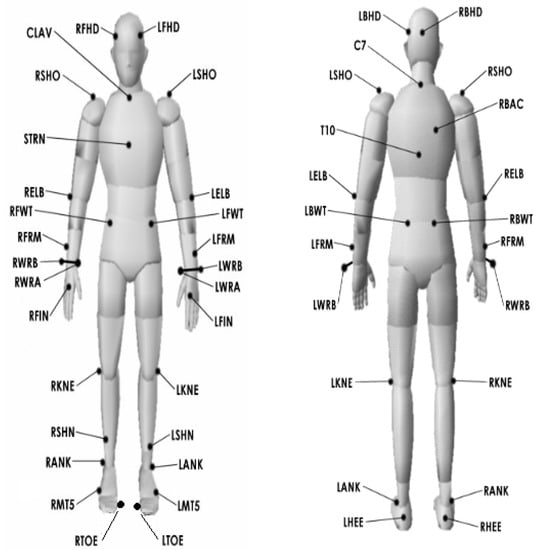
Figure 1.
The locations of reflective markers.
2.3. Experimental Procedure
Warming up for the roundhouse kicks was allowed. After warming up, the participants performed their favorite stretching, stepping, and kicking. For the angle-change footwork, textured marks were placed on the ground for each angle so that participants could become familiar with each angle. All participants practiced until they were comfortable with the specific angles and lengths of the backsteps. The participants were then instructed to perform a kicking process that included footwork followed by a roundhouse kick to strike the target mitt as quickly as possible with a bare foot immediately after the flashing LED light. Five trials were conducted with a 5 min break before the subsequent trial’s data collection.
2.4. Trial Conditions
2.4.1. The Roundhouse Kick without Footwork
As shown in Figure 2, all participants performed the roundhouse kick without footwork. All participants were right-footed; therefore, the left leg was the supporting leg, while the right was the kicking leg in the trials.
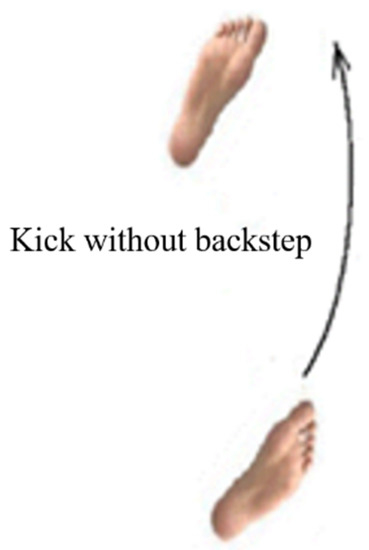
Figure 2.
The roundhouse kick without backstep.
2.4.2. Roundhouse Kicks with Angle-Change Types of Footwork (One-Foot Backstep)
The participant’s left foot became a pivot point in the one-foot backstep movement. Six conditions were used, as follows (Figure 3):
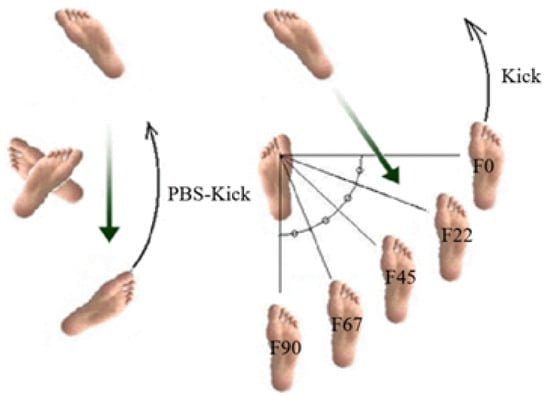
Figure 3.
Angle-change types of footwork.
- the preferred backstep (PBS) roundhouse kick, in which the participants used their preferred angle;
- one-foot backstep roundhouse kicks at different angles (0°, 22°, 45°, 67°, and 90°).
The angles between the left foot and the x-axis clockwise were 0°, 22°, 45°, 67°, and 90°. The preferred target distance of each participant was used.
2.4.3. Roundhouse Kicks with Distance-Change Types of Footwork (Backstep with Both Feet)
Five conditions were used, as follows (Figure 4):
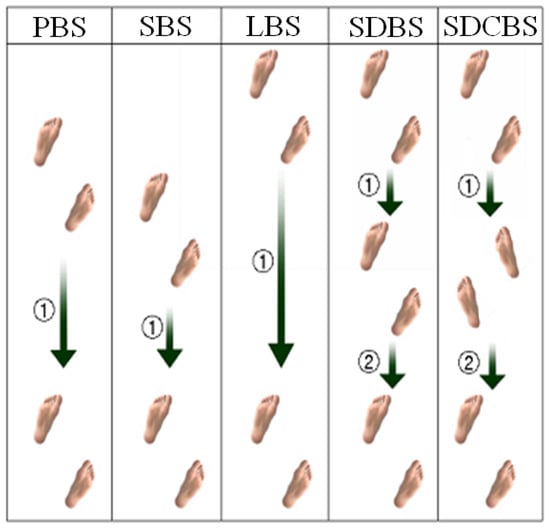
Figure 4.
Distance-change types of footwork.
- a roundhouse kick with a preferred-distance backstep with both feet (PBS);
- a roundhouse kick with a short-distance backstep with both feet (SBS);
- a roundhouse kick with a long-distance backstep with both feet (LBS);
- a roundhouse kick with a short-distance double-backstep with both feet (SDBS);
- a roundhouse kick with a short-distance double-cross-backstep with both feet (SDCBS).
During the warm-up procedure, each participant performed the backstep movements five times. Then, the average distance of those backstep movements was calculated (PBS). The SBS distance was the average distance minus 30% of the average value; the LBS distance was the average distance plus 30% of the average value; the SDBS distance was two times that of the SBS; and the SDCBS was two times that of the SBS with the cross-backstep. Each participant’s preferred distance from the target was used.
2.5. Data Reduction and Analysis
The signal, start, preparation, kick, minimum knee flexion (MKF), and impact were identified as a set of actual events to analyze data (Figure 5). The start (the start of the backstep motion) was visually determined using the movements of the right toe and heel markers. Preparation was described as the completion of the backstep and readiness to kick. The moment the kicking foot toe left the ground was defined as a kick. MKF was the moment when the kicking leg had the minimum knee flexion. The point when the marking on the target mitt began to move was considered the impact. At the MKF and impact events, the contribution of the body segments to toe velocity was calculated. For marker tracking, the best trial from each condition was chosen. Kwon3D software digitized motion capture data to find reflective markers. The reflective markers’ 3D coordinates were generated using a DLT algorithm and smoothed with an 8 Hz low-pass 4th-order Butterworth filter.
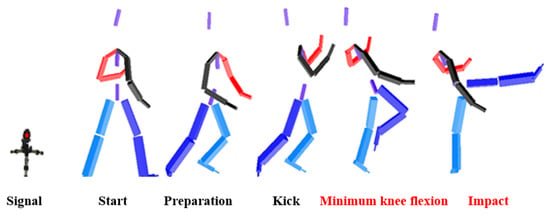
Figure 5.
The events of the roundhouse kick.
The contribution was calculated by analyzing the effect of segments of the whole body, trunk, thigh, calf, and foot on the final distal segment, the toe velocity. The velocity of the foot segment is the sum of the velocity of the whole-body center of mass (VG) and the relative velocity of the foot segment with respect to the whole-body center of mass. That is, Vfoot = VG + Vfoot/G, and if the velocity of the foot segment is further subdivided by the same method, it is as follows:
where VTK/G is the velocity of the body center of mass with respect to the whole-body center of mass, Vhip/TK is the velocity of the hip joint with respect to the trunk center of mass, Vknee/hip is the velocity of the knee joint with respect to the hip joint, Vankle/knee is the knee joint velocity, and Vfoot/ankle is the velocity of the center of the foot relative to the ankle joint. According to Ginsberg and Genin [27], the velocity (Vd/p) of the distal segment relative to the proximal segment can be expressed as follows:
Vfoot = VG + VTK/G + Vhip/TK + Vknee/hip + Vankle/knee + Vfoot/ankle
Vd/p = ωi/GR × rd/p + (Vd/p)rad
Here, ωi/GR × rd/p is the tangential component of the relative velocity, ωi/GR is the angular velocity of the segment with respect to the ground, and rd/p is the position vector of the distal segment with respect to the proximal segment. (Vd/p)rad is the centripetal component of the relative velocity. The following formula was applied to the trunk, thigh, calf, and foot:
Vfoot = VG + VTK/G +
ωTK/GR × rfoot/TK +
ωthigh/TK × rfoot/hip +
ωshank/thigh × rfoot/knee +
ωfoot/shank × rfoot/ankle +
(Vhip/TK)rad + (Vknee/hip)rad + (Vankle/knee)rad + (Vfoot/ankle)rad
ωTK/GR × rfoot/TK +
ωthigh/TK × rfoot/hip +
ωshank/thigh × rfoot/knee +
ωfoot/shank × rfoot/ankle +
(Vhip/TK)rad + (Vknee/hip)rad + (Vankle/knee)rad + (Vfoot/ankle)rad
In the above equation, VG is the contribution of the foot segment velocity to the whole-body center; VTK/G is the contribution of the trunk center mass to the whole-body center of mass; ωTK/GR × rfoot/TK is the contribution of trunk rotation; ωthigh/TK × rfoot/hip is the contribution of the rotation of the thigh segment; ωshank/thig × rfoot/knee is the contribution of the rotation of the calf segment; ωfoot/shank × rfoot/ankle is the contribution of the rotation of the foot segment; and (Vhip/TK)rad + (Vknee/hip)rad + (Vankle/knee)rad + (Vfoot/ankle)rad includes the centripetal components for the relative velocities of the hip joint to the body’s center of mass, the knee joint to the hip joint, the ankle joint to the knee joint, and the foot segment center to the ankle joint, respectively.
Since the direction of the contributing factors to the foot segment velocity by each body part obtained by this equation can be different from the foot segment velocity, it was projected onto the vector direction of the foot segment and calculated as the contributing factor to the foot segment velocity. The centripetal component was calculated as the result of excluding the remaining contributing factors to the foot segmental velocity.
For the contribution analysis, the MKF event, which is the moment when the knee of the kicking leg converts from bending to extension, and the impact event, which is the moment when the target’s marker starts to move when the foot hits the target, were used. The contribution to toe velocity was calculated from whole-body movement, trunk movement, trunk rotation, thigh rotation, calf rotation, foot rotation, and others. Repeated-measures analysis of variance with footwork as a within-subject factor was used to determine whether there were any statistically significant differences between dependent variables among the footwork conditions (footwork without backstep, angle-change types, and distance change types). Post hoc tests were performed with the Bonferroni adjustment. Alpha (a) was set at 0.05 in all statistical analyses.
3. Results
3.1. Contributions of Body Segments in Minimum Knee Flexion (MKF) Event
Table 1 contains the contributions of the segments to the toe velocity in the minimum knee flexion (MKF) event with angle-change types of footwork. In all types of kicks, thigh rotation showed the most significant contribution with a rate of 51.0 to 64.4%, and trunk rotation had the second highest contribution rate (16.7 to 29.9%). Whole-body movement (10.1 to 13.4%) was ranked third, and the contribution rate of trunk movement was 4.6 to 7.8%, indicating a significant difference between types of footwork.

Table 1.
The contributions of the roundhouse kick with angle-change types of footwork in MKF event. Units: m/s.
During the kick without a backstep, the toe velocity was 10.45 m/s in the MKF event, the contribution rate of thigh rotation was 53.9%, the contribution rate of trunk rotation was 24.3%, the contribution rate of whole-body movement was 12.4%, the contribution rate of trunk movement was 6.5%, the contribution rate of calf rotation was 2.5%, the contribution rate foot rotation was 0.2%, and the contribution rate of others was 0.3% The contribution of thigh rotation was the highest, followed by trunk rotation and whole-body movement.
The results from the types of one-foot backstep footwork showed that the toe velocity at F0° was 8.05 m/s, that at F22° was 9.05 m/s, that at F45° was 9.47 m/s, that at F67° was 9.85 m/s, and that at F90° was 10.87 m/s. The velocity of the toe increased with an increase in the angle, and there was a statistically significant difference.
There was a statistically significant difference in toe velocity, and the difference in toe velocity was a result of increasing the contribution of whole-body movement, trunk movement, and trunk rotation. The toe velocity influenced by thigh rotation also increased with an increase in the movement angle, but it did not reach the increase rate of the toe velocity, so the contribution rate to the toe velocity decreased as the movement angle increased. The toe velocity influenced by trunk rotation also increased to 1.46 m/s, 1.51 m/s, 2.05 m/s, 2.26 m/s, and 2.51 m/s as the angle increased. The contribution rate was 18.1% in F0 and 16.7% in F22, in which the toe velocity was low, and it increased to 21.6%, 22.9%, and 23.1% as the angle increased.
Table 2 contains the contributions of the segments to the toe velocity in the minimum knee flexion (MKF) event with distance-change types of footwork. The toe velocity was 9.83 m/s for PB, 10.28 m/s for LB, 9.96 m/s for SB, 10.10 m/s for CBS, and 10.49 m/s for DSB. There was no statistical difference in the toe velocity across the distance-changes types of footwork. However, there was a statistically significant difference between SB and CBS, between SB and DSB in whole-body movement, and between SB and DSB in trunk movement. Similar to the results of the type of angle change, it was found that the contribution was greatest for thigh rotation, followed by trunk rotation, and whole-body movement.

Table 2.
The contributions of the roundhouse kick with distance-change types of footwork in MKF event. Units: m/s.
3.2. Contributions of Body Segments in Impact Event
Table 3 includes the contributions of the segments to the toe velocity in the impact event with angle-change types of footwork. Compared with the contributions in the MKF event, the contribution of thigh rotation decreased, while the contribution of the calf rotation increased significantly. In addition, the toe velocity was 15.52 m/s in the roundhouse kick without a backstep, and to reach this velocity, the contribution rate by thigh rotation was 39.8%, the contribution of calf rotation was 34.6%, the contribution of trunk rotation was 12.0%, the contribution of whole-body movement was 9.6%, the contribution of trunk movement was 8.4%, the contribution of foot rotation was 2.9%, and the contribution of others was −7.3%.

Table 3.
The contributions of the roundhouse kick with angle-change types of footwork in impact event. Unit: m/s.
In the roundhouse kick with PBS, the toe velocity was 14.87 m/s, the contribution rate of whole-body movement to reach the velocity was 8.7%, that of trunk movement was 7.8%, that of trunk rotation was 18.3%, that of thigh rotation was 36.5%, that of calf rotation was 36.8%, that of foot rotation was 2.5%, and that of others was −10.6%. In the angle-change types of footwork, the toe velocity at F0° was 13.66 m/s, the toe velocity at F22° was 13.72 m/s, the toe velocity at F45° was 14.06 m/s, the toe velocity at F67° was 15.64 m/s, and the toe velocity at F90° was 15.44 m/s. As the movement angle increased, the toe velocity increased. However, there was no statistically significant difference. The toe velocity by thigh rotation also increased to 3.60 m/s, 4.23 m/s, 4.68 m/s, 5.09 m/s, and 5.49 m/s with an increase in the angle, and the contribution rates also increased from 26.4% to 30.8%, 33.3%, 32.5%, and 35.5% as the backstep angle increased. Unlike the results of the kick without backstep, the contribution rate by calf rotation was higher than that of the thigh rotation, except for F90. The contribution rates of trunk rotation for PBS, F45°, F67°, and F90° were 17.8% to 18.5%, but those of F0° and F22° were 23.7% and 21.6%, respectively. The contribution rates of whole-body movement and trunk movement were similar at 7.8% to 9.9% for PBS, F45°, F67°, and F90°, but they were low at 3.3% to 5.8% for F0° and F22°.
Table 4 includes the contributions of the segments to the toe velocity in the impact event with distance-change types of footwork. The toe velocity of PB was 16.75 m/s, and to reach this velocity, the contribution rate of whole-body movement was 8.1%, the contribution of trunk movement was 7.5%, the contribution of trunk rotation was 19.5%, the contribution of thigh rotation was 37.9%, the contribution of calf rotation was 35.4%, the contribution of foot rotation was 1.6%, and the contribution of others was −10.0%. In the roundhouse kick with PB, thigh rotation contributed the most, followed by calf rotation, trunk rotation, and whole-body movement.

Table 4.
The contributions of the roundhouse kick with distance-change types of footwork in impact event. Unit: m/s.
In distance-change types of footwork, there were statistically significant differences in velocity and the contribution rate of whole-body movement and trunk movement, such as with the angle-change types of footwork. However, there was no statistical difference in toe velocity.
4. Discussion
The purpose of this study was to quantitatively examine the effects of various footwork techniques often used in Taekwondo sparring matches on the biomechanical contributions of body segments to toe velocity during Taekwondo roundhouse kicks. In this study, the authors analyzed the contributions on the basis of both angle-change-type footwork and distance-change-type footwork in two events, the MKF event and the impact event, and found that the footwork affected toe velocity and contribution variables significantly.
First, in the minimum knee flexion event, the thigh rotation showed the most significant contribution in all types of footwork, followed by trunk rotation and whole-body movement. On the other hand, the contribution rate of calf rotation was −2.2 to 7.0%, and the contribution rate due to foot rotation was −3.0 to 2.8%, indicating a negative value and impairing toe velocity. This is because of the characteristics of the MKF event, which is converted from flexion to extension motion. During roundhouse kicks with angle-change types of footwork, the toe velocity increased with the angle, and there was a significant difference in the toe velocity. However, in the distance-change types of footwork, there was no statistical difference in the toe velocity caused by footwork.
Second, in the impact event during the roundhouse kick with PBS, the contribution rate to the toe velocity was the largest from calf rotation, followed by thigh rotation, trunk rotation, and whole-body movement. In addition, the contribution rate of calf rotation in the angle-change-type footwork was higher than that of thigh rotation, except for F90. Although there was no significant difference in the velocity of calf rotation, the contribution rate decreased as the angle increased, indicating that the type with a smaller backstep angle relies on knee extension motion to kick more.
The contribution rates of whole-body movement and trunk movement were similar for PBS, F45, F67, and F90, but those for F0 and F22 were lower than those of the others. This means that when the movement angle was small, it depended more on trunk rotation than on trunk movement, and as the movement angle increased, it depended on whole-body and trunk movement rather than trunk rotation.
Third, as shown in Figure 6, as the Taekwondo round kick progresses from the minimum knee flexion event to the impact event, the contribution of thigh rotation is reduced, and the contribution of calf rotation is increased. This can be explained by the kinetic link theory proposed by Plagenhoef [28] and Bunn [29], that is, the deceleration of the thigh helps increase the velocity of the calf, and the deceleration of the calf contributes to the production of maximum toe velocity. This is also consistent with the results of Yoon’s study [30], which showed that hip flexion contributes to the velocity of the foot segment, and when the rotation velocity of the thigh is decelerated, the rotation velocity of the calf increases and contributes to the velocity of the foot segment.
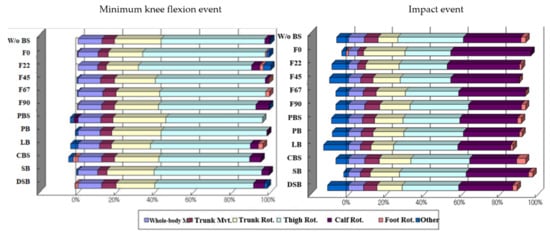
Figure 6.
Comparison of the contribution rates in MKF and impact events.
In the study by Yoon [30], the contribution of body segments to the toe velocity of the roundhouse kick was 5.81% whole-body movement, 3.25% trunk movement, 10.11% trunk rotation, 27.28% thigh rotation, 29.29% calf rotation, and 1.43% foot rotation. The results of this previous study were different from the results of the current study. The difference is due to the difference in the form of the roundhouse kick. According to the Taekwondo textbook [31], the roundhouse kick is executed by ‘Bending the knee of the kicking leg while the weight is placed on the foot that is the front axle, and when turning the body, straighten the folded knee, and the foot rotates horizontally and strikes, and the support leg should stretch the knee and ankle so that the body rotates well’. In addition, it should be performed in the form of a shot slightly above the target. On the other hand, for the roundhouse kick in the case of a sparring match, the player should jump one step forward from the sparring posture, and the whole body should be thrown forward while the pelvis rotates [32].
The former (Taekwondo textbook) emphasizes the kick by the supporting foot and trunk rotation, while the latter emphasizes weight shift and hip rotation in the target direction. In the previous study, the contribution of whole-body movement was 5.81%, and that of trunk movement was 3.25%, and in this study, the contribution of whole-body movement was 9.6%, and that of trunk movement was 8.4%. The current study shows that the contributions of whole-body movement and trunk movement were higher than those in the previous study, so it is thought that the previous study used the roundhouse kick based on the former form, and the current study employed the roundhouse kick based on the latter form.
One limitation of the current study was that the footwork was predetermined and remained constant throughout the kick performance. Competitors in sparring constantly slide or step forward and backward and left to right to respond and execute the counterattack. Naturally, the footwork type might be modified throughout the kick’s execution, which requires the attacking competitor to adjust the footwork movement to compensate for the opposing contender’s movement. Future studies should use a more realistic footwork condition plan, such as executing a counterattack with side footwork following the actual systematic alteration of attacking.
Author Contributions
Conceptualization, T.J. and H.P.; methodology, T.J. and H.P.; software, T.J. and H.P.; validation, T.J. and H.P.; formal analysis, T.J. and H.P.; investigation, T.J. and H.P.; resources, T.J. and H.P.; data curation, T.J. and H.P.; writing—original draft preparation, T.J. and H.P.; writing—review and editing, T.J. and H.P.; visualization, T.J. and H.P.; supervision, T.J. and H.P.; project administration, T.J. and H.P. All authors have read and agreed to the published version of the manuscript.
Funding
This research received no external funding.
Institutional Review Board Statement
The study was conducted in accordance with the Declaration of Helsinki and approved by the Institutional Review Board (or Ethics Committee) of Yongin University (YIU07DOC19).
Informed Consent Statement
Informed consent was obtained from all subjects involved in the study.
Data Availability Statement
Not applicable.
Conflicts of Interest
The authors declare no conflict of interest.
References
- Fife, G.P.; O’Sullivan, D.M.; Pieter, W.; Cook, D.P.; Kaminski, T.W. Effects of Olympic-style taekwondo kicks on an instrumented head-form and resultant injury measures. Br. J. Sports Med. 2013, 47, 1161–1186. [Google Scholar] [CrossRef] [PubMed]
- Miziara, I.M.; da Silva, B.G.; Marques, I.A.; de Sá, A.A.R.; Oliveira, I.M.; Pereira, A.A.; Naves, E.L.M. Analysis of the biomechanical parameters of high-performance of the roundhouse kicks in Taekwondo athletes. Res. Biomed. Eng. 2019, 35, 193–201. [Google Scholar] [CrossRef]
- Jung, T.; Park, H. The effects of back-step footwork on taekwondo roundhouse kick for the counterattack. Eur. J. Hum. Mov. 2020, 44, 129–145. [Google Scholar] [CrossRef]
- Falco, C.; Alvarez, O.; Castillo, I.; Estevan, I.; Martos, J.; Mugarra, F.; Iradi, A. Influence of the distance in a roundhouse kick’s execution time and impact force in Taekwondo. J. Biomech. 2009, 42, 242–248. [Google Scholar] [CrossRef] [PubMed]
- Koh, J.O.; Watkinson, E.J. Video analysis of blows to the head and face at the 1999 World Taekwondo Championships. J. Sports Med. Phys. Fit. 2002, 42, 348. [Google Scholar]
- Kim, J.; Kwon, M.; Yenuga, S.S.; Kwon, Y. The effects of target distance on pivot hip, trunk, pelvis, and kicking leg kinematics in Taekwondo roundhouse kicks. Sports Biomech. 2010, 9, 98–114. [Google Scholar] [CrossRef]
- Pieter, F.; Pieter, W. Speed and force in selected taekwondo techniques. Biol. Sport 1995, 12, 257–266. [Google Scholar]
- Menescardi, C.; Lopez-Lopez, J.A.; Falco, C.; Hernandez-Mendo, A.; Estevan, I. Tactical aspects of a National University Taekwondo Championship in relation to round and match outcome. J. Strength Cond. Res. 2015, 29, 466–471. [Google Scholar] [CrossRef]
- Falco, C.; Alvarez, O.; Estevan, I.; Molina-Garcia, J.; Mugarra, F.; Iradi, A. Kinematic and kinematical analysis of Dominant and Non-Dominant kicking leg in a roundhouse kick in taekwondo. In Scientific Proceedings of the 27th International Conference on Biomechanics in Sports; Harrison, A.J., Anderson, R., Kenny, I.C., Eds.; Original Writing & Biomechanics Research Unit: Limerick, Ireland, 2009; pp. 600–603. [Google Scholar]
- Jung, T.; Park, H. The effects of defensive footwork on the kinematics of Taekwondo roundhouse kicks. Eur. J. Hum. Mov. 2018, 40, 78–95. [Google Scholar]
- Kim, S.H.; Chung, K.H.; Lee, K.M. Taekwondo Kyorugi: Olympic Style Sparring; Turtle Press: Wethersfield, CT, USA, 1999. [Google Scholar]
- Lust, K.R.; Sandrey, M.A.; Bulger, S.M.; Wilder, N. The effects of 6-week training programs on throwing accuracy, proprioception, and core endurance in baseball. J. Sport Rehabil. 2009, 18, 407–426. [Google Scholar] [CrossRef]
- Putnam, C.A. A segment interaction analysis of proximal-to-distal sequential segment motion patterns. Med. Sci. Sports Exerc. 1991, 23, 130–144. [Google Scholar] [CrossRef] [PubMed]
- Estevan, I.; Falco, C.; Silvernail, J.F.; Jandacka, D. Comparison of lower limb segments kinematics in a Taekwondo kick. An approach to the proximal to distal motion. J. Hum. Kinet. 2015, 47, 41–49. [Google Scholar] [CrossRef] [PubMed] [Green Version]
- Changkuk, K. Kinematic analysis of Taekwondo round kick motion. Korean Soc. Sport Biomech. 1992, 2, 24–36. [Google Scholar]
- Estevan, I.; Alvarez, O.; Falco, C.; Molina-García, J.; Castillo, I. Impact force and time analysis influenced by execution distance in a roundhouse kick to the head in taekwondo. J. Strength Cond. Res. 2011, 25, 2851–2856. [Google Scholar] [CrossRef] [PubMed]
- Tang, W.T.; Chang, J.S.; Nien, Y.H. The kinematics characteristics of preferred and non-preferred roundhouse kick in elite Taekwondo athletes. J. Biomech. 2007, 40, S780. [Google Scholar] [CrossRef]
- Estevan, I.; Falco, C.; Álvarez, O.; Molina-García, J. Effect of Olympic weight category on performance in the roundhouse kick to the head in taekwondo. J. Hum. Kinet. 2012, 31, 37–43. [Google Scholar] [CrossRef] [Green Version]
- Lee, J.; Park, I. Effects of stepping-in-place tempo and type of roundhouse kick on coincidence-anticipation timing in Taekwondo. Int. J. Perform. Anal. Sport 2022, 22, 209–224. [Google Scholar] [CrossRef]
- Shin, J.M.; Choi, J.Y. The comparison of relative motion of distal segment about proximal segment of Dolyeochagi in Taekwondo. Korean J. Sport Leis. Stud. 2001, 15, 545–556. [Google Scholar]
- Sant’Ana, J.; Franchini, E.; da Silva, V.; Diefenthaeler, F. Effect of fatigue on reaction time, response time, performance time, and kick impact in taekwondo roundhouse kick. Sports Biomech. 2017, 16, 201–209. [Google Scholar] [CrossRef]
- Estevan, I.; Falco, C.; Jandacka, D. Mechanical Analysis of the Roundhouse Kick According to the Stance Position. A Pilot Study. In ISBS-Conference Proceedings Archive, Proceedings of the 29 International Conference on Biomechanics in Sports, Porto, Portugal, 1–27 July 2011; International Society of Biomechanics in Sports: Konstanz, Germany, 2011. [Google Scholar]
- Li, Y.; Yan, F.; Zeng, Y.; Wang, G. Biomechanical Analysis on Roundhouse Kick in Taekwondo. In ISBS-Conference Proceedings Archive, Proceedings of the 23 International Symposium on Biomechanics in Sports (2005), Beijing, China, 22–27 August 2005; International Society of Biomechanics in Sports: Konstanz, Germany, 2005. [Google Scholar]
- Wąsik, J.; Shan, G. Target effect on the kinematics of Taekwondo Roundhouse Kick—Is the presence of a physical target a stimulus, influencing muscle-power generation? Acta Bioeng. Biomech. 2015, 17, 115–120. [Google Scholar] [CrossRef]
- Falco, C.; Molina-García, J.; Álvarez, O.; Estevan, I. Effects of target distance on select biomechanical parameters in taekwondo roundhouse kick. Sports Biomech. 2013, 12, 381–388. [Google Scholar] [CrossRef] [PubMed]
- Abdel-Aziz, Y.I.; Karara, H.M.; Hauck, M. Direct linear transformation from comparator coordinates into object space coordinates in close-range photogrammetry. Photogramm. Eng. Remote Sens. 2015, 81, 103–107. [Google Scholar] [CrossRef]
- Ginsberg, J.H.; Genin, J. Statics, Dynamics: Combined Version; John Wiley and Sons: New York, NY, USA, 1977. [Google Scholar]
- Plagenhoef, S.; Curtis, D. Patterns of Human Motion: A Cinematographic Analysis; Prentice-Hall: Englewood Cliffs, NJ, USA, 1971. [Google Scholar]
- Bunn, J.W. Scientific Principles of Coaching; Prentice-Hall: Englewood Cliffs, NJ, USA, 1972. [Google Scholar]
- Yoon, C. Contribution of Body Segment to Foot Velocity in Tae Kwon Do Kicking Motion; Seoul National University: Seoul, Korea, 1997. [Google Scholar]
- Kukkiwon. Taekwondo Textbook; Osung: Seoul, Korea, 2006. [Google Scholar]
- Kang, S. Analysis of the Patterns of the Biomechanical Characteristics in Taekwondo Kicking Techniques; Sungkyunkwan University: Seoul, Korea, 1998. [Google Scholar]
Publisher’s Note: MDPI stays neutral with regard to jurisdictional claims in published maps and institutional affiliations. |
© 2022 by the authors. Licensee MDPI, Basel, Switzerland. This article is an open access article distributed under the terms and conditions of the Creative Commons Attribution (CC BY) license (https://creativecommons.org/licenses/by/4.0/).